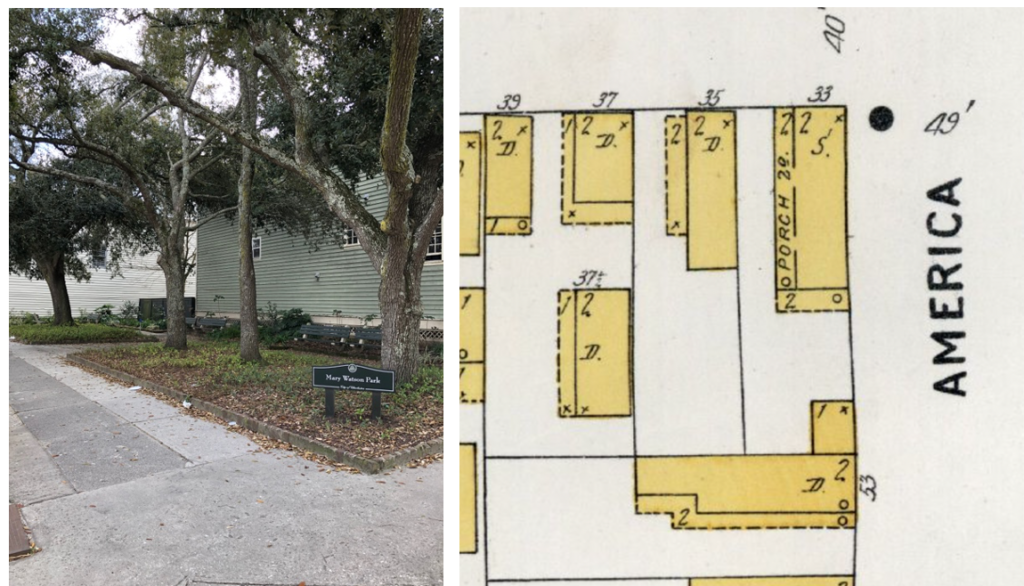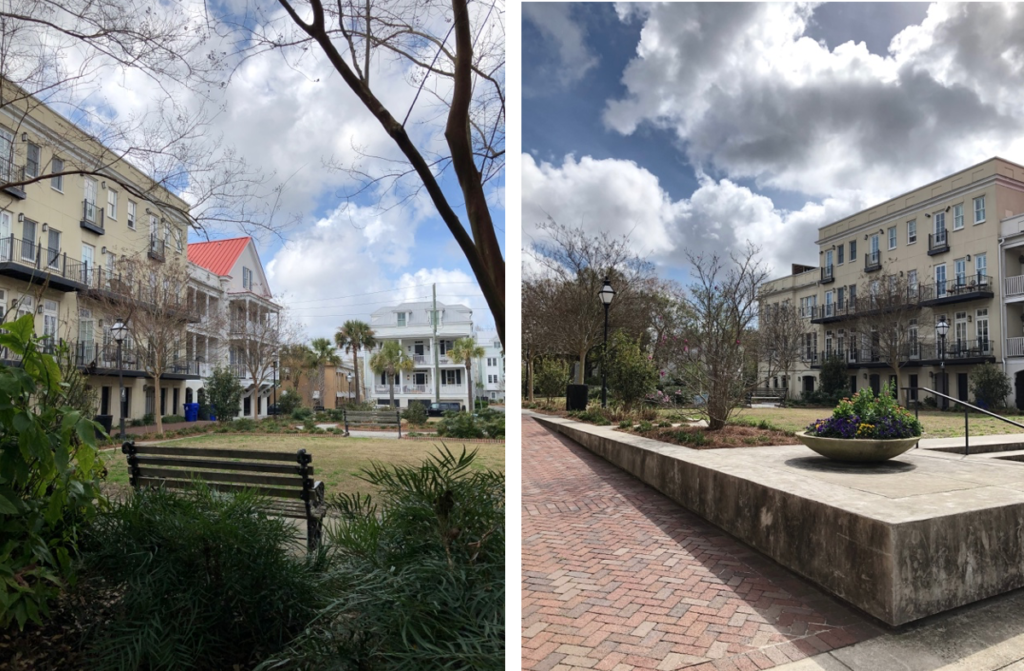Downtown Charleston’s middle peninsula neighborhoods- Hampstead/East Side, Radcliffeborough, and Cannonborough-Elliottborough- punch above their weight in neighborhood amenities. Aside from the convenient walking distance to Upper King Street’s award-winning restaurants and night life and their proximity to jobs in the medical and tech sectors, each boasts several unique parks that offer a perfect place to sit and enjoy nature or to exercise, right in the midst of the city.

In Hampstead/East Side lies Hampstead Mall, Charleston’s oldest public greenspace, predating White Point Garden by more than sixty years. The mall is one of four squares that were laid out by Henry Laurens in 1769 as the original core of Hampstead Village. At that time, Columbus and Aiken Streets, which now travel through the park, stopped short of the squares, and carriages had to ride along the periphery. Hampstead Square measured 450 feet on each side and a newspaper advertisement for the surrounding residential lots stated that Laurens would retain the “large square . . . in the center of the town for such public uses and purposes, as shall be agreed upon by the first twenty-one purchasers of the lots, or a majority of them.”


Hampstead Mall is the most intact of the quadrants and is lined with mature live oaks and benches for visiting with neighbors. Two crisscross shell paths converge in the middle of the mall, where a bronze statue to Philip Simmons (1912-2009) sits. Mr. Simmons, an African American man born on Daniel Island, grew up in the East Side and began smithing at age 12. He was nationally renowned for his wrought ironwork, which is on display in the Smithsonian and throughout the city. The other quadrants are used as Mall Playground and basketball court, a fenced sport field currently managed by Charleston County School District, and an additional park with a pergola and fountain adjacent to Trident Technical College.
One block south, there is a small pocket Mary Watson Park at the intersection of America and Amherst Street. It is named in honor of the founder of Mary’s Sweet Shop, an important African American owned corner store, which has been in operation since 1958. The shop, across the street from the park dedicated to Mary, is still operated by her son, Joe Watson. Formerly the site of a two-story Charleston single house, the mini-park has a water fountain for passing joggers and benches surrounded by plantings maintained by the East Side Garden Club.

Further north, Martin Field and Park, bounded by Lee, Jackson, Hanover, and America Streets, is the largest sports area serving the middle peninsular boroughs. The now-lovely park began with humble origins as a marsh-side trash dump. Historic Nic Butler notes that both residents and the city health department complained about the site and smell of the dump; there was a large incinerator on the site and “in addition to the work performed by municipal hogs, the health department periodically poured kerosene over the trash-filled marshes and burned everything to ashes. Combustible materials scattered among the garbage occasionally exploded during such episodes or ignited on their own, requiring emergency assistance from the fire department.”
In 1929, the city began to transform the offensive site into a public greenspace and what are now in Charleston’s coolest boroughs. The incinerator building became a “comfort station” for visitors coming to town via the brand-new Grace Bridge over the Cooper River. After the bridge opening festivities were over, the city began work on a new greenspace, which was named in October 1930 in honor of John Elmore Martin (1859-1921), a city councilman, police chief, and longtime sheriff. The “comfort station” was converted into a community center in 1935 and was eventually demolished and replaced with a ball court.

The park features a multi-purpose field, tennis courts, baseball diamond, basketball courts, and Martin Luther King Pool, the largest public pool in the City of Charleston. The Olympic sized swimming pool was opened in 1973 and was recently completed renovated to include a retractable glass enclosure to create an indoor pool facility in the cold months. There is an Art Deco style concrete memorial for Sherriff Elmore on the edge of the park, designed by noted Charleston Renaissance architects Simons and Lapham. The memorial, erected in 1932 was once part of a larger fountain and reflecting pool that has since been filled in.


Cannonborough-Elliottborough, one of Charleston’s coolest boroughs, lies just west of Hampstead across King Street, also has several unique greenspaces. The boroughs are named for the Elliott family, who subdivided part in 1786, and Daniel Cannon, who owned the other portion. Elliottborough Park at 134 Line Street began as a farm when the land was outside the city limits. As development crept up the peninsula, the lot became home to the City Stables, where the Streets and Garbage Department mules resided until the 1920s, when the stable was replaced with a brick garage. That historic facility is still intact on the western edge of the park. The park includes a playground, seating areas, and a community garden.
Morris Street, which runs through the residential heart of the neighborhood closer to Radcliffeborough, is home to two small parks: Simonton Park and Dereef Park. Both sit on lands once owned by Joseph and Richard Edward Dereef, who were some of Charleston’s wealthiest free people of color during the antebellum era (this historic term refers to persons of African descent who were not enslaved.). The Dereefs were lumber factors, real estate developers, and slave owners. Joseph Dereef sold part of his lands to the city in 1854 to extend Morris Street west from Coming to Rutledge, making development and the future park possible.

Dereef Park was once Dereef Court, which was lined with small wooden residences. These were demolished in the twentieth century, but the infill site did not stay vacant for long. The park opened in 1993 but the land had become valuable, and part was later offered for sale. After several years of controversy between residents and the city about how the land should be used, the rear portion was developed with town houses and the Morris Street fronting portion was formally turned into Dereef Park.
Its focal point is a now-renovated praise house building that used to sit further back in the lot but was relocated to Morris Street for preservation. Praise houses are an important, mostly rural African American phenomenon, and they are typically small wood frame buildings for non-denominational worship. The Dereef Park praise house was apparently built or repurposed in 1943 by John H White, pastor of United Missionary Chapel. Though the praise house was long vacant when the park was developed, the city has installed signage about the building’s rich history and deep community importance. Dereef Park has a well-manicured greenspace that is a favorite for neighborhood dogs and children, and benches for relaxing in the shade.
If you have an interest in this area, speak with one of our local real estate agents to learn more about the location and current listing.

Simonton Park lies across Morris Street, and, like Dereef Park, the site had an earlier use. It is named for the Simonton School, a public elementary school for African American children during the days of segregated education. At that time, the Dereef Court area of Elliottborough was an integrated neighborhood that was home to African American artisans and professionals; there are still several historic African American law firms and churches on Morris Street. The stately four-story masonry building was closed in 1968 and demolished in the 1970s. The land sat vacant more than thirty years, until developers purchased it to construct Morris Square, a mixed use residential and commercial enclave, with a public green space in the midst. I’on Group created the community greenspace in 2008, noting that “you have a yard, its owned by everybody.” The surrounding row houses give the park, with its central fountain and inviting benches, a distinctly Mediterranean feel.



The MUSC Urban Garden on the nearby Medical University campus might be the best kept secret in Radcliffeborough. The campus has a traditional U-shaped layout with sidewalks, plantings, and benches which opens onto Rutledge Avenue, as well as many small well-curated greenspaces between the historic houses and large medical buildings that are part of the MUSC complex today but tucked away at the corner of Bee and President Streets is a dynamic, bustling half acre garden hidden in plain sight. The mission of the farm is “to build a healthier community by growing crops and social connections while educating and inspiring people with local, nutritious, and delicious food.” Plants include herbs known historically for their medicinal purposes and food stuffs, and there is a cobb pizza oven on site. Volunteers tend the farm and MUSC periodically hosts workshops and tours of the half acre city garden.

To learn more about the Charleston area and current real estate listings, contact one of our Charleston realtors!
Sources:
- City of Charleston/ Debra L/ Morgan. A historic Architectural Resources Survey of Dereef Court and Park Area. December 2017.
- “The Life and Times of Dereef Park.” Charleston City Paper. 3 August 2011.
- Southern Environmental Law Center. “In Charleston, new life for a heritage park.” July 2017. https://www.southernenvironment.org/news-and-press/news-feed/in-charleston-new-life-for-a-heritage-park
- Charleston Parks Conservancy. “Elliottborough Park.” https://www.charlestonparksconservancy.org/park/elliotborough-park-and-community-garden
- City of Charleston. Area Character Appraisal: Cannonborough-Elliottborough. Charleston, August 2009.
- Nic Butler. “Hampstead Village: the historic heart of Charleston’s East Side.” October 2019. https://www.ccpl.org/charleston-time-machine/hampstead-village-historic-heart-charlestons-east-side
- “Pool Foundation Laid”. Charleston News & Courier. October 19, 1973. pp. 1-B. Retrieved October 17, 2013.
- Nic Butler. “A Trashy History of Charleston’s Dumps and Incinerators.” September 2020. https://www.ccpl.org/charleston-time-machine/trashy-history-charlestons-dumps-and-incinerators
- City of Charleston. Charleston Yearbooks, 1929, 1930, 1932-35.
- South Carolina and American General Gazette, 20–27 November 1769.
- Medical University of South Carolina. “Urban Farm.” https://web.musc.edu/resources/health-and-wellness/ohp/urban-farm
- Ricky Dennis Jr. “In Jim Crow era, Mary Watson borrowed $800 to start East Side business, a community hub.” 11 December 2019.

